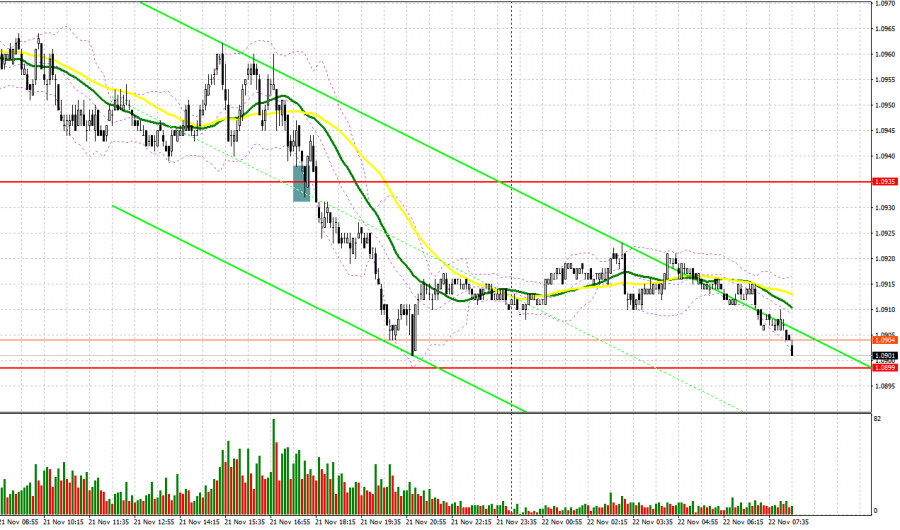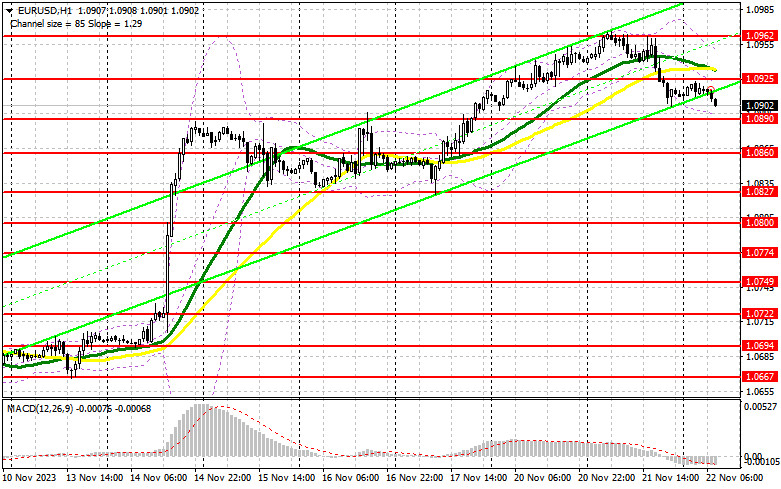
Yesterday, the pair formed only one entry signal. Let's have a look at what happened on the 5-minute chart. In my morning review, I mentioned the level of 1.0970 as a possible entry point. Despite my expectations, the price failed to break through the monthly high. Due to low market volatility, it also missed about 20 pips to reach the levels I mentioned before. In the afternoon, a decline to 1.0935 and its false breakout generated a good buy signal. However, the pair failed to develop an upside momentum, so I had to close positions with losses.

For long positions on EUR/USD
Yesterday's Federal Reserve meeting minutes revealed a more hawkish stance than anticipated, resulting in a drop of the euro against the US dollar. The Federal Reserve seems reluctant to hasten interest rate cuts, prompting a market reaction. Today, we're anticipating the Eurozone financial stability report and consumer confidence data. ECB Executive Board member Frank Elderson's speech might not be critical, but it's worth listening to due to the lack of substantial fundamental data. Given the ongoing correction in the euro, an optimal buying strategy would be to look for a false breakout around the 1.0890 level. This could provide a good entry point for long positions, aiming for further growth and testing the 1.0925 resistance formed yesterday. A break and a downward retest of this range, coupled with positive Eurozone reports, would signal another buying opportunity, potentially retesting the monthly high around 1.0962. The ultimate target here is the 1.1004 area, where I plan to take profits. Should EUR/USD decline and show no activity at 1.0890 in the first half of the day, this could spell trouble for the euro buyers. In such a case, the market could be entered after a false breakout around the next support at 1.0860. I would consider opening long positions immediately on a rebound from 1.0827, aiming for an upward correction of 30-35 pips within the day.
For short positions on EUR/USD
While sellers have made their presence felt, their ability to maintain positions remains a complex issue. In the event of a pair's rise, it's crucial to make a move around the nearest resistance of 1.0925, just above which the moving averages are playing on the side of sellers. A false breakout there would signal a selling opportunity, aiming for a downward correction and testing the support at 1.0890, where I expect major buyers to emerge. A breakout and consolidation below this range, followed by a bottom-up retest, would provide another signal to sell, targeting 1.0860. The farthest target would be the 1.0827 low, where profits should be taken. In case EUR/USD moves upwards during the European session without bearish activity at 1.0930, the trade would remain within a sideways channel. This, however, would pave the way for buyers to reach the monthly high of 1.0962. It is also possible to sell there but only after unsuccessful consolidation. I would consider opening short positions immediately on a rebound from 1.1004, aiming for a downward correction of 30-35 pips.

COT report
The Commitments of Traders (COT) report for November 14 indicated a notable increase in long positions and a significant reduction in short positions. The recently released inflation data clearly indicated that the current cycle of interest rate hikes in the US has reached its peak, significantly impacting the US dollar and reducing short positions on the euro, thereby reviving demand for it. The upcoming publication of the minutes from the Federal Reserve's November meeting is anticipated, where traders will seek answers to remaining questions. However, it is already apparent that rates have peaked and a reduction is expected next year. According to the COT report, non-commercial long positions increased by 8,707 to 221,190, while non-commercial short positions decreased by 11,144 to 112,283. Consequently, the spread between long and short positions increased by 3,283. The closing price saw a sharp rise, settling at 1.0902 compared to the previous value of 1.0713.
Indicator signals:
Moving Averages
Trading below the 30- and 50-day moving averages indicates a decline in the euro.
Please note that the time period and levels of the moving averages are analyzed only for the H1 chart, which differs from the general definition of the classic daily moving averages on the D1 chart.
Bollinger Bands
If the pair declines, the lower band of the indicator at 1.0890 will act as support.
Description of indicators:
• A moving average of a 50-day period determines the current trend by smoothing volatility and noise; marked in yellow on the chart;
• A moving average of a 30-day period determines the current trend by smoothing volatility and noise; marked in green on the chart;
• MACD Indicator (Moving Average Convergence/Divergence) Fast EMA with a 12-day period; Slow EMA with a 26-day period. SMA with a 9-day period;
• Bollinger Bands: 20-day period;
• Non-commercial traders are speculators such as individual traders, hedge funds, and large institutions who use the futures market for speculative purposes and meet certain requirements;
• Long non-commercial positions represent the total number of long positions opened by non-commercial traders;
• Short non-commercial positions represent the total number of short positions opened by non-commercial traders;
• The non-commercial net position is the difference between short and long positions of non-commercial traders.